This is an essay on the choices that standards enable. By laying out a framework for ensuring interoperable, interchangeable and substitutable components, standards make it easier for you, the consumer, to shop with confidence and take full advantage of the choices offered in the marketplace.
Let’s take the humble floor lamp as an example, and look at some of the standards that govern its design, and the choices this enables for the consumer. In the United States, many of the parameters for electrical fixtures are governed by standards promulgated by the National Electrical Manufacturers Association (NEMA). Some of these standards are approved by ANSI or the IEC as well.
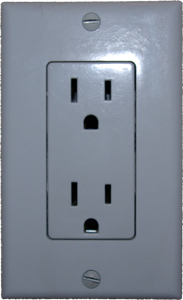
Let’s start at the wall. We see here a NEMA 5-15 Type B 3-Pin duplex socket. As you may notice, the left slot is slightly taller than the right one. This is the neutral. The live line is on the right, and the ground is on the bottom.
This socket is rated for 5 Amps at 125 Volts. The definition and calibration of the Amp and Volt and other key values in the Metric or SI system of measurement are standardized by the General Conference on Weights and Measures (CGPM).
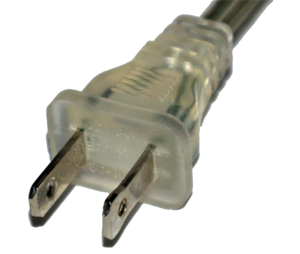
From the lamp we have the male end, an AC power plug. On my lamp the connector is a polarized, ungrounding NEMA 1-15P plug.
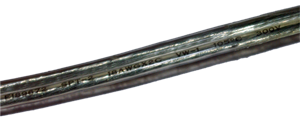
This is an electrical cord for the lamp. The codes indicate that this is a SPT-2 , #18 gauge flexible cord. SPT (Service Parallel Thermoplastic) is a standard defined by the American Society for Testing and Materials (ASTM) and approved by Underwriters Laboratories (UL). The gauge is measured in American Wire Gauge (AWG) units, also known as the Brown & Sharpe gauge, a standard dating back to 1855.
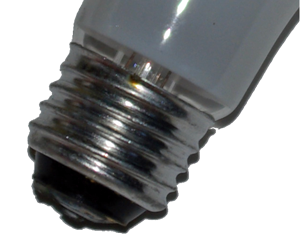
A critical interface is the one between the bulb and the lamp. The most-common connection in the United States is called the MES or Single Contact Medium Edison Screw (E26). This is an ANSI Standard, C78.20-2003.
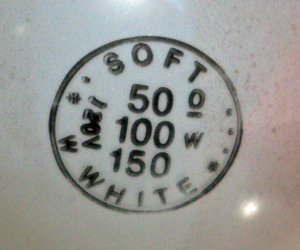
The bulb itself is an NEMA A21-style bulb, with an E26d style base. It will be 134.9 mm long, 28.2mm wide at the base. The height of the conductor screw will be 24.4mm. As indicated, this is a three-way bulb, rated at 50W, 100W and 150W.
As you can see, the inputs and outputs of the lamp are heavily-constrained by a number of standards. Is this a bad thing? Is the consumer deprived for not having to worry about different plug and outlet types, or what gauge cord to use for their lamp, or what thread connection to use? On the contrary, it is a blessing for the consumer that such pieces are interchangeable commodities.
If one bulb burns out, you can replace it with whatever brand is cheapest. Or you can get a lower wattage one to save electricity. Or even get a florescent one that fits in the same Medium Edison Screw socket. You can get clear glass, soft white, red glass or black light. You have these choices because bulb standards make bulbs interchangeable.
If the dog chews on the cord and you need to replace it, there is no need to return the lamp to the manufacturer at great expense. SPT-2 cords are standard and available at any hardware store. You can simply replace it yourself.
If you move to another house, will your lamp stop working and need to be thrown out? No, of course not. The NEMA 15-5 power outlets are in every home in North America. You can use your lamp wherever you go.
What if you want to buy a new lamp next year, will you need to change the wiring or the outlets in your house to work with it? Certainly not. The power outlets are a standard will work with any lamp, the ones you have today, the old ones you buy at an flea market, or the ones you buy 10 years from now. The standards ensure interoperability, interchangeability and substitutability.
In fact, far from constraining choice, standards enable greater choice. Because the basic plugs, receptors and connectors are governed by standards, these core components have become commodities and are produced off-shore at low cost to you, the consumer. This causes lighting designers and manufacturers to compete on the basis of style, elegance, utility and features. So standards result in lower cost, greater competition and greater choice for the consumer.
These are the choices enabled by standards, and the choices that consumers want:
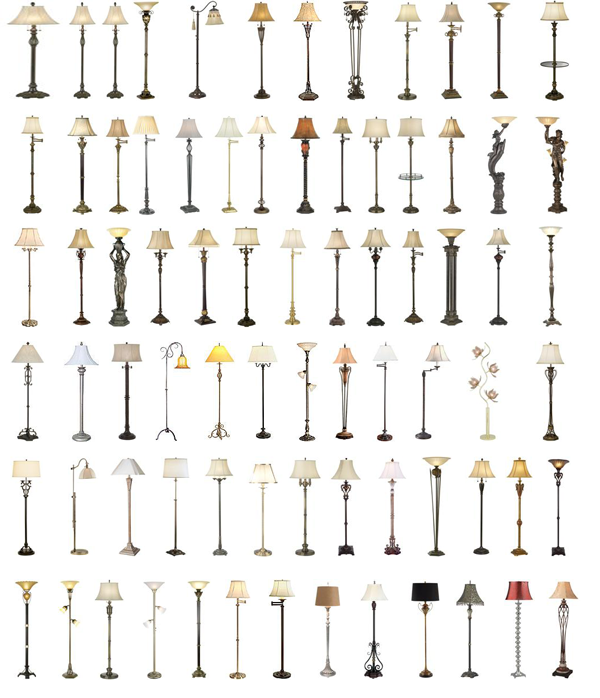
It is the same thing with document formats. Consumers don’t want to worry about document formats. They don’t want to even think about document formats. They just want them to work, invisibly, without problems. Of course consumers want choice, but it is the choice of applications, choice of features, choice of vendors, choice of support options, choice of open source versus proprietary source, choice of heavy weight versus web-based, a choice of buying a single application versus buying a suite, etc. A single universal file format is what makes these other choices possible, just like a choice of the Medium Edison Screw bulb leads to an affordable choice in lamp designs.
To perpetuate vendor-specific file formats is like having a lamp that requires a special plug and a special light bulb and even special electricity. It is to go through life with a bag full of adapters and transformers that you will need to apply whenever you, or someone else, needs to use your document in another application. The cost of multiple document standards is that the industry will invest in a wide variety of convertors between the formats, and this cost will be passed on to the consumer. These convertors will work sometimes, but will inevitably be slower, buggier, have less fidelity, and their availability will lag the office applications by months or years.
The choice is yours.
Updates:
2/14/2007: A discussion of one critic’s response to this essay can be read in this follow-up.
My salary doesn’t depend I my being blind to your irrefutable logic. So it makes perfect sense to me. Beautiful sense. I’ll be curious as to how the shills and trolls will try to find errors in the logic. I think I will preempt them by asking why they haven’t lobbied NEMA to allow European style plugs and outlets so as to allow more “choice” for our lamps and appliances.
I don’t think this analogy helps your case. There are many partially overlapping standards for electrical device connections in use in a typical US home, e.g. for 110-volt low amperage plugs/sockets, (symmetrical plugs), 110-volt polarized plugs, 110-volt grounded plugs, 220 volt plugs. There are adapters for sale in every hardware store to mix and match these to the extent technically possible, but there is loss of functionality if you use an adapter to mate a grounded plug with an ungrounded socket.
Then there are all the different combinations of voltage and amperage used in electronic devices. If you are careful to read the specs on both sides, you can mix and match them.
Manufacturers pick the standard that meets the technical requirements of the appliance or device, and consumers manage to deal with it. Nobody is calling for dryers to work on 110 volt current, or for all nightlights to have grounded plugs, in the name of having only one standard. The electronics power supply device situation is a hassle, to be sure, but do you really want designers to be forced to pick some spec (12 volt 3 amp, or whatever) and somehow make everything from an iPod to a high-end laptop work with that single standard?
Manufacturers do support multiple standards where possible and where there is a consumer benefit. For example, most laptops work with either 110 or 220 volt current, so operating a device built for Europe in North America, or vice versa, is just a matter of using an adapter to make the plugs match. No need to haul around a voltage step up/down transformer anymore.
This pattern is true across industries – We have different grades of gasoline and diesel, we have milk with different amounts of fat, we have different grades of meat, organic vs non-organic choices in most everything. Even without OOXML, document producers / consumers will have to choose between DocBook, ODF, and several flavors of HTML. The idea that one standard fits all needs in a government-defined niche reminds most people of opressive bureaucracy, not the choice that Western consumers have.
Richard, I am someone being blessed with the choice you’re suggesting. As I live in Germany and have been in the US from time to time, I have even experienced that this choice is costly as some governments suggested in the OOXML ISO approval process. Now I own a power plug adapter that doesn’t work with my laptop as well as a universal US power adapter for laptops (< 60W).
I think you prove my point. The electrical connectors conform with each other, since they are part of the same standard and are standardized by the same body. So an unpolarized plug will fit in a polarized receptor. And a three-pin grounded receptor will accept a two-pin polarized plug. This works well in practice.
And of course, I’m not suggesting a single universal file format that works for everything from spreadsheets to CAD diagrams to relational databases. I’m only suggesting that there should be a single standard file format for spreadsheets. This is much more analogous to having a single standard for electrical connectors for floor lamps, i.e., it is a specific, limited problem domain.
You need to ask yourself, are different spreadsheet programs akin to a floor lamp and a washing machine, with such incompatible requirements that the plugs are by design incompatible? Or are they more like different floor lamps, that differ in some features, but have much more in common? If the later, then it makes sense to standardize the commonality and have an extensible mechanism (XML-based) for expressing the differences.
A different kind of Diogenes lamp.
But who will set the standards for standards?
OOXML made it through ECMA.
Another example is that really horrible but standard cigarette lighter outlet for cars. It would be so much easier and convenient to use something smaller and more secure, but everyone uses the old socket model. Or the telephone (with the current interrupter as well as touch-tones).
(USB connector for 5v applications seems to be gaining, but we’ll see)
The CD took a long time to kill off LPs and only recently have cassettes disappeared (my audiobook store over the last two years had to change as new cars didn’t have cassettes). The DVD is doing the same to VHS (but betamax died) – we’ll see if HD-DVD can displace it. Still, software moving from floppy all moved to some CD and/or DVD format – and the discs are the same size.
NTSC/PAL seem alive and well and destined to outlive us all, I don’t see HD security cameras and monitors coming out anytime soon. And FM radio with 19Khz stereo split.
Standards tend to be persistent. Which do you want to be using 40-70 years from now, OOXML or ODF?
Think of the children!
I’d rather be using ODF, thank you. Why? Because it’s simpler. Rob makes an elegant, concise argument in favor of how a standard frees the industry to get on with its business, rather than the constant tail-chasing of media and formats we do in the computer world.
If for no other reason, by using ODF I don’t have to pay Microsoft a “tax” to access my data. That alone should settle any argument: control.
If 90% of the world is using the same plug and the same voltage and the same frequency then even if there comes along a better new plug and an upgraded version that is compatible with the old plug that does not mean both plugs should not be standardised.
The new plug might have new possiblities but the upgrades plug might be cheap to implement and already satisfies current needs.
The upgrade plug might have been useful if it hadn’t been found to be detrimental to my health or been unreliable in the suppliers past attempts. Not much use if it electrocutes me in the process.
That’s why we have 3 prong outlets that allow for the legacy two prong format to be preserved – at the same time providing better grounding for the future and the safety of our children.
However we have no need for another 3 prong outlet when one has already been standardized. That would just confuse the situation and cost more than the “might” be cheaper costs of your proposed upgrade.
In addition given the history of the supplier as a convicted criminal and being well known for their shoddy work – the chances they would get the wiring backwards and electrocute me with something that had the specific intent of protecting me is rather high.
Feel safe knowing the current 3 prong standard spent 4 years being processed rather than 30 days. It demonstrates that safety rather supplier self-interest and convenience was the priority – especially given your proposed standard is 10x the size of the existing standard – so maybe you can wait 40 years – that would be about right. But then again I’m more concerned about my kids and their financial future than making a buck now at their expense.
Good point, but spreadsheets are far more complicated than lamps!
Perhaps a better comparison would be a lamp with a fixed 1×1 spreadsheet whose only cell contains the formula =ISPOWERON(), and whose graphing capabilities consist of a white or black screen, depending on the value of that formula.
Certainly spreadsheets are more complex than lamps. That argues for a more complex standard, not for the absence of a standard. There are also very simple things in life, like ice cream cones, that lack standards.
So I think the think that recommends something for standardization is not the complexity, or lack of complexity, but the degree to which that item requires coordination to reach its best (highest value) use. For example, in the pre-industrial, pre-factory world,we had fewer standards. But once industrialization showed the value of the economics of interchangeable parts then we required standards to measure and specify these interchangeable parts. And when documents were written on parchment by cloistered monks, document standards were limited. Even spelling was not standardized. But with electronic documents, exchanged around the world in an instant via email and the web, with a receiver using an operating system and application that is not known to you, then a more detailed document standard is called for.